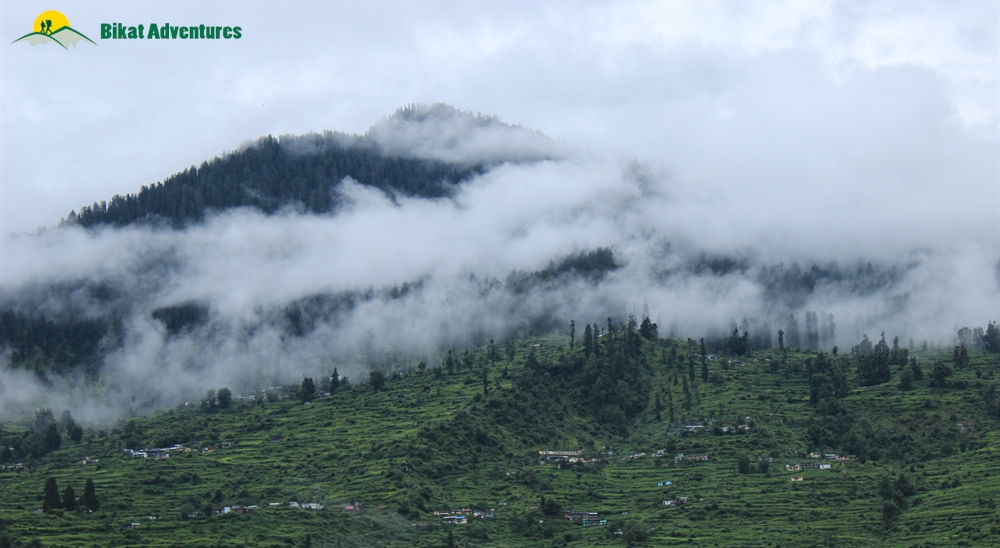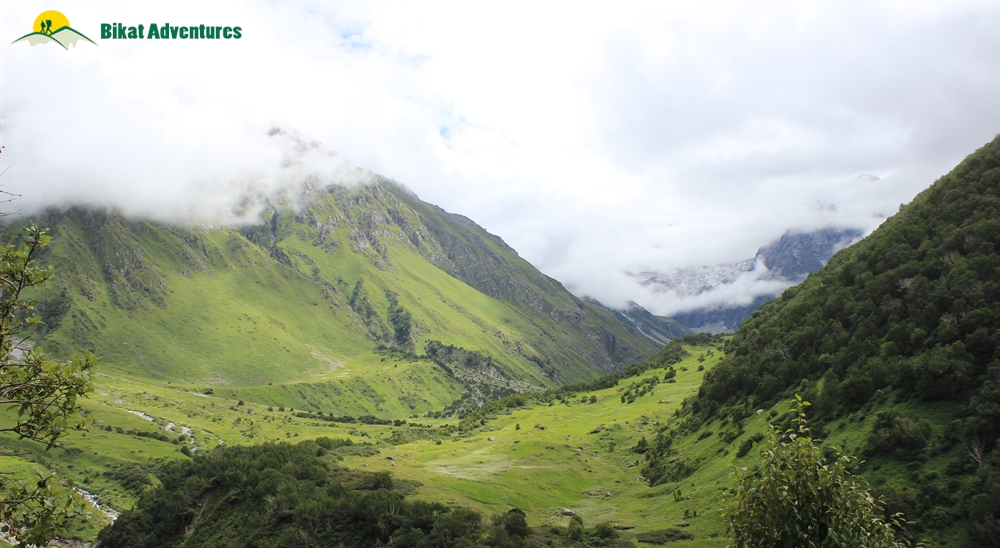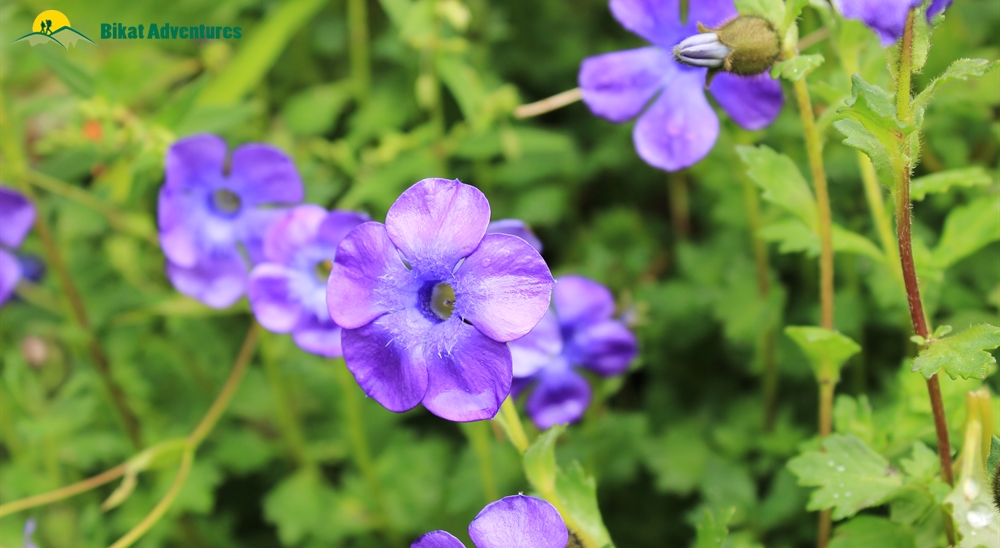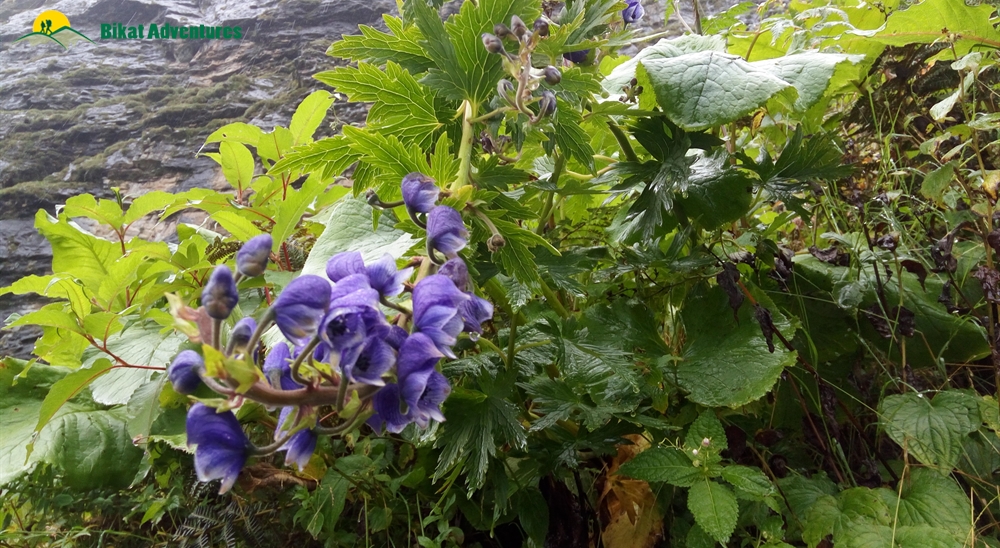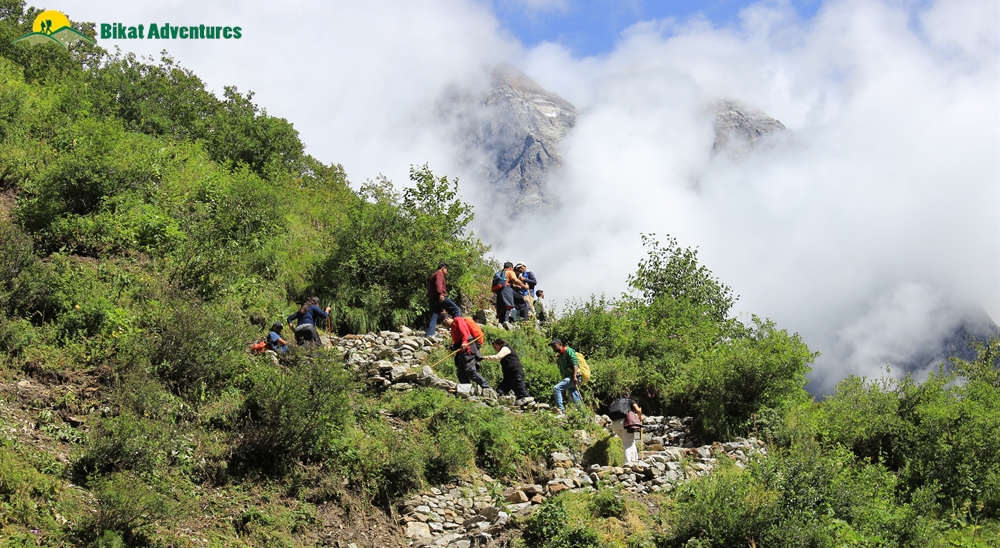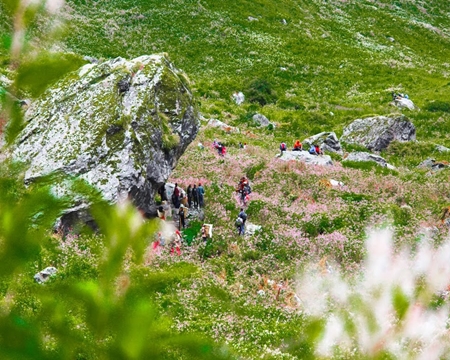Description
Valley of flowers trek has gained a lot of popularity in recent years. The Idea of watching a valley flooded with flowers of all variety and colors can be tempting for any nature lover. The local folklore also complements the aura of this valley. They go to the extent that at times the scent of flowers can be so strong that the visitors fall unconscious. We haven’t experienced anything like this but it definitely has some truth in it. Considered as one of the most beautiful Valley treks in the Himalayas, the valley is studded with some of the most colorful, beautiful and pristine flowers there is. Depending on the season, the flowers display a unique array of colors and patterns that will leave you spellbound. It was declared a national park in 1982 and it is also a UNESCO world heritage site. The trek to Valley of Flowers will also allow you to trek to the religiously significant Hemkund Sahib, a gurudwara nestled at a staggering height of 14,000 FT. The chance to include a trek with spirituality and scenic beauty is glorious. The best time to visit Valley of Flowers is between July and August when the wildflower blooms are the most vibrant of any found throughout India in the rest of the year. We recommend that you should do Valley of flowers trek yourself i.e. without any trek operator's help as the logistics of the trek are very simple and can be easily done by any trekker - beginner or seasoned. Read this blog to know more about why you should do it yourself and how! https://www.bikatadventures.com/Home/Blog/valley-of-flowers-trek-be-done-without-any-tour-operator
Itinerary
Itinerary
Show complete Itinerary
Dehradun - Govind Ghat
It is best to reach Dehradun the previous night. There are plenty of state-run buses and shared taxis that will take you from Dehradun all the way to Govindghat. These buses/taxis leave from Dehradun between 5-8am. Alternatively, you can hire a private taxi from Dehradun to Govindghat. Travel time from Dehradun to Govindghat is 12-14 Hours. Stay in Guest House/Hotel in Govindghat/Joshimath for the night.

Govind Ghat to Ghangria (13Kms)
The trek traditionally starts from Govindghat but these days there is a possibility to reach Pulna and save a 3 Km hike from Govindaghat. However, the movement of taxis till Pulna is restricted and permits are given to an only limited number of vehicles. If you have a permit, then you can start from Pulna else start from Goindghat. The route from Govindghat to Pulna is on the tarmac and the gradient is easy. From here, take the well-marked cemented trail after crossing the bridge on river Alakhnanda. Govindghat has a Gurudwara & few hotels where one can stay. The trail to Ghangaria is usually crowded with the pilgrims who are headed for Hemkund Sahib. There are trees of Apricot alongside the trail. The entire trail to Ghangaria winds along the river with cascading waterfalls & natural water springs which present a very refreshing sight. It takes about 6 hours to reach Ghangaria which is a small village lined with food joints & a Gurudwara. Stay overnight in Guest house/hotel in Ghangaria.

Ghangria to Valley of Flowers and back (10 Kms)
After breakfast trek to Valley of Flowers from Ghangaria. Start early to have more time at hand when you are in the Valley. After walking on the relatively flat trail till the bridge where we cross Pushpawati, the climb to the valley is steep. Fortunately, the climb is only around 1.5 Kms long before the valley dawns upon you. The valley is an enchanting sight with an impressive array of rare wildflowers. Some of the technical names of flowers found here are : Geranium, Marsh marigold, Prinula, Potentilla, Geum, Asters, Lilium, Ranunculus, Corydalis, Inula, Braham kamal, Campanula, Pedicularis, Arisaema, Morina, Impatiens, Bistorta, Ligularia, Anaphalis, Saxifrages, Sibbaldia, Thermo- psis, Trollius, Codonopsis, Dactylorhiza, Cypripedium, Strawberry, Epilobium, Rhododendrons and numerous others. Most of the flowers have medicinal values too. We will walk for about 10 Kms in the Valley. The valley is normally carpeted with flowers of an array of colors: Green, Blue, Yellow, Red. In the far distance, you can see snow clad peaks. One of the attractions of the valley is a refreshing stream named Pushpawati, into which several tiny streams and waterfalls merge. Since the trek is fairly easy you will have sufficient time to relax & absorb the beauty of this wonderful place. Soak your feet in the stream & enjoy the sight. Camping in the Valley is not permitted so you will have to trek back to Ghangaria retracing the same route. Stay overnight at your hotel in Ghangaria.

Ghangria to Hemkund Sahib and back (10 kms )
Today's trek is beautiful but the same time steep & arduous. The altitude is on the higher side & weather can be pretty unpredictable. The months when this trek is done are peak monsoon months and rains can get us stranded if you do not descend in time. It is advisable to start at 5 AM to have the advantage of time. It takes approx. 4 hours to reach Hemkund Sahib Lake. This lake remains frozen for 6 months. Perched at an elevation of 4,329 mts above sea level, Hemkund Sahib is the highest Gurudwara of Sikh community. Warm yourself inside Gurudwara and it is recommended to start descending before 2 PM.

Ghangria to Govind Ghat (13 Kms)
Start your trek by 6 am. It is an easy 13 km mostly downhill walk from Ghangria to Govind Ghat. At a consistent pace, you will reach Govind Ghat by 11 am. You may choose to leave to Dehradun immediately or stay overnight at Govind Ghat and depart to Dehradun the following morning.

Departure day
Depart from Govind Ghat to Dehradun in the morning.
Frequently Asked Questions
Pick your question
Eligibility: Is this trek good for me?
This trek is ideal for both beginners and experienced trekkers. For the novice, it is a great start to enter the world of trekking. It can get a bit rigorous for the first-timers. Therefore, it is recommended to the first timers to maintain good physical stamina and read extensively. Any trekker would love to go on this trek for the love of its views and trekking.
Eligibility: Experience required
This trek is apt for the first-timers. Those coming for the first time should prepare and read extensively about the trek. Basic knowledge about trekking and mountain mannerisms will come in handy.
Eligibility: Fitness benchmark
1. Jog/Run for 3 Kms in 30 mins and
2. Hold your breath for 20 seconds
If you are not meeting these benchmarks, please use the preparation schedule to improve your fitness till you achieve the above benchmarks.
Eligibility: Requisite Skills
1. How to choose a right rucksack: It is essential that you choose a right rucksack for the trek since you are going to carry it all the time while trekking. Make sure you don’t make these common mistakes while buying a rucksack.
2. How to pack a rucksack: Trekking in mountains become more fun when your rucksack is well-organized. It also makes it easier for you to carry without being much load on your shoulders. Follow the guidelines on how to pack a rucksack.
Best Season:
The best time to visit Valley of Flowers trek is between July and August when the wildflower blooms are the most vibrant.
Packing List: What to pack
Click here for text packing list.
Packing List: How should I pack my rucksack?
Packing List: How should I select my trekking shoe?
Connectivity: How to Reach the base of the trek & how to go back from the end point?
Valley of Flowers is not connected by any motorable road. The nearest place is Govindghat (near Joshimath) which is approximately 17 km from Valley of Flowers. This distance can be covered by trekking. Reaching Joshimath is not a tough task as it is well connected to Dehradun and New Delhi.
By Road:
There are frequent buses from ISBT Kashmere Gate in Delhi to Dehradun, followed by taking a shared taxi or a local bus to Joshimath or Govindghat. The journey from Dehradun to Joshimath takes approximately 8 hours. Alternatively, you can take a taxi from Dehradun to Joshimath or Govindghat.
By Rail:
There is no direct rail connectivity to the Valley of Flowers. Rishikesh is the nearest railway station to the same, 272 km away from the Valley. Regular buses ply between Rishikesh and Govindghat.
By Air:
There is no direct flight connectivity to the Valley of Flowers. Jolly Grant Airport in Dehradun is the nearest commercial airport. You can hire a cab from the airport which will take you directly to Govindghat.
Connectivity: What is the cellular network connectivity for this trek?
BSNL network is available till Ghangria.
Nearby attraction: What are the nearby attractions that I can explore?
Around 14kms from the Valley is the beautiful hamlet of Govindghat, a favorite among pilgrims. Some 30kms away, nestled in the mountains of Chamoli, lies the town of Joshimath which is a gateway to the sacred town of Badrinath, one of the four dominant Char Dham pilgrimage sites in India. Approx. 40km away is the quaint village of Mana, the last Indian village from the border of India and Tibet in the Himalayas. It’s been designated as a “Tourism Village” by the Uttarakhand government. Another popular destination for any tourist is the hill station of Auli.
Accommodation: What will be the accommodation type in this trek?
There are plenty of guesthouses/hotels on the trail. Accommodation will not be a problem at all. However, during peak season the rooms will get sold out soon. So, plan accordingly.
Weather conditions: What will the temperatures be like during this trek?
Monsoon, from mid-July to end of August, is the best season to visit the valley. Days remain pleasant, with highs of 17 degrees Celsius, while the nights are cool, with a minimum temperature of 7 degrees celsius.
Weather conditions: When will there be snow on this trek?
There will be snow only in the winter months of November to April during which the valley cannot be accessed.
About the activity: Why should I go for this trek?
Valley of Flowers trek
The Valley of Flowers trek, a UNESCO world heritage site, is ideal for watching a valley flooded with flowers of all variety and colors can be tempting for any nature lover. The local folklore also complements the aura of this valley. It is the perfect trek for beginners and can be easily trekked to on our own without the need of any tour operator.About the activity: Why should I go for this trek?
Valley of Flowers trek
The Valley of Flowers trek, a UNESCO world heritage site, is ideal for watching a valley flooded with flowers of all variety and colors can be tempting for any nature lover. The local folklore also complements the aura of this valley. It is the perfect trek for beginners and can be easily trekked to on our own without the need of any tour operator.Age limit: What is the minimum & maximum age limit?
The minimum age limit is 9 years. However, minors aged between 9 to 17 should be accompanied with their parents or guardians. If you are above the age of 60, kindly carry a medical certificate from your doctor that deem you fit for adventure activities like trekking.
Equipment and facilities: What kind of tents and sleeping bags will be provided to us?
We provide 4 seasons tents by Gipfel for higher altitudes which can easily withstand heavy snowfall and storms. They are spacious enough to accomodate 3 people at once with a vestibule to place the backpacks Our sleeping bags are made up of Heatseeker Pro synthetic insulation that can provide you comfort in -10 degrees celsius. We also use additional fleece liners to have thermal efficiency even in the extreme temperatures of -17 degrees Celsius. If you carry your own sleeping bag, you will get a cashback reward, provided that you inform us as soon as you have booked your trek.
Equipment and facilities: What equipment can I rent from you?
You can rent following items from us- Trekking Pole, Trekking Shoes, Fleece Jacket, Rucksack
Equipment and facilities: What kind of food will be provided for the trek?
Vegetarian food will be served throughout the trek. The only non-vegetarian item served on our treks are eggs. Our kitchen staff follows a proper menu for breakfast, lunch and dinner which has been designed in order to fulfil the nutritional requirements of the participants. There will be milk, poha, eggs, muesli/corn flakes, bread and butter served for breakfast. Rice or simple roti sabzi will be packed for lunch. In dinner, you will have dal, egg curry or any other vegetarian dish along with rice, roti, and a dessert item. Packed lunch will be provided to you on the days you are trekking. You are requested to carry your own tiffin box and a mug to consume food. The meals consumed on journey and arrival day are not included in our cost.
Equipment and facilities: If we trek in snow, what equipment will you provide?
You will be provided with good quality of gaiters and microspikes from us depending upon the situation of the snow. Our trek leaders will also be carrying ropes and ice axe.
Equipment and facilities: Are there any washroom/toilet facilities on the trek?
Toilet tents will be provided to you on the trek.These are portable toilets tents where a deep pit will be dug. A shovel will be provided inside the tent to cover the waste after you have made your business. You can take a toilet roll inside. Make sure you dig used toilet paper along with the waste. Though water is recommended in place of toilet paper. Please refrain from using wet wipes as they are non-biodegradable. There will be no facility for bathing on the trek. Go through our blog section for tips on how to maintain personal hygiene on treks.
Miscellaneous : Is there an option to offload my backpack?
If you want to offload your rucksack, you will have to make a request for offloading a few days prior the trek through an email so that arrangement can be made in advance. You will be charged per day for offloading your rucksack. In case you decide to offload on the spot, you may have to pay a higher price than usual. However offloading your rucksack is not recommended since it is not a safe practice.
Miscellaneous : Who will lead us on the trek?
A team of participant will be led by a course certified trek leader and a local guide. All participants are requested to abide by what their leader says. There will also be a team of kitchen staff and porters on the trek. We maintain 1:8 ratio of trek leader and participants. All our trek leaders and staff have a certified training in first-aid and rescue operation.
Miscellaneous : Is the trekking pole necessary?
It is not mandatory but it is more convenient with the pole. If you don’t want to buy one, you can rent it from us on minimal daily basis charges. You can request the renting link from us.
Miscellaneous : Are there any local stores/shops from where I can shop trekking necessities?
Yes, there are stores and shops in Joshimath from where you can buy necessary stuff. Though it is recommended that you come prepared with all the stuff. Please do not leave anything for last minute buying.
Miscellaneous : Is it safe for a solo woman traveller to trek in Fixed departures?
Yes, it is absolutely safe for solo woman to travel in fix departures. Women on the trek will be sharing tent with each other. In case you are the only woman on the trek, you will be given a separate tent.
Miscellaneous : Will you give certificates on completion of trek?
Yes, e-certificates will be given at the end of each trek provided that you completed it. It will bear your name, the trek, and the maximum altitude you achieved on the trek.
Transport: In case we opt for the transport with you, where will you pick us from and where will you drop?
We will pick you up from ISBT Dehradun. Drop off point remains the same.
Transport: What time will you drop us at the end point on last day of the trek?
Expect to reach Dehradun ISBT by late evening.
Mandatory documents: What are the mandatory documents required for the trek?
No mandatory documents are required for the trek.
Why Bikat
Reviews
What's Included
Whats Included
Whats Not Included?
Cancellation Policy
Cash Refund
Cancellations up to 30 days prior to departure date
5% Deduction
Between 30 days to 15 days prior to departure
50%
deduction
Less than 15 days of departure
No Cash Refund
Voucher Refund
Cancellations up to 5 days prior to departure date
No Deduction
Cancellations less than 5 days prior to departure
No Refund
Please note
- Cash refund is applicable only in case of bookings made without using any promotional offer code or vouchers.
- This is only a brief of cancellation terms. For finer details please refer Detailed Cancellation Policy.
Blog Posts

Bucket List Treks For 2019
Kiritika Jyotshi 09 January 2019
As travelers, we have constant urges to explore new places and expand the picture gallery of our phones with the bittersweet memories from our trips. Our love for the unseen places just keeps increasing and trust us, it becomes an addiction before
Read More


